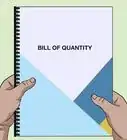This article was co-authored by Perryn Olson. Perryn Olson is a Construction Specialist and the VP of Marketing for REX Construction Services, REX Engineering Group, and REX Technology Solutions. He holds a BA in Visual Arts from Loyola University New Orleans and is a Certified Marketer with the Society of Marketing Professional Services and the Construction Marketing Association.
There are 13 references cited in this article, which can be found at the bottom of the page.
wikiHow marks an article as reader-approved once it receives enough positive feedback. In this case, 92% of readers who voted found the article helpful, earning it our reader-approved status.
This article has been viewed 158,102 times.
When submitting a bid proposal for a construction project, you are competing against other businesses and trying to convince a client to hire you. It is important that your bid looks professional and that it includes all requested information. Take enough time to accurately estimate your costs and then draft your bid.
Steps
Calculating the Costs
-
1Read the project details. You can't estimate until you know what you must build. Get the blueprints or other project details and read them until you understand them thoroughly.
- Ask the owner questions if anything is unclear. Incomplete or indecipherable plans frequently lead to cost overruns, so clear up confusion before submitting a bid.[1]
- Also think if anything is missing from the specifications. For example, don't forget permits and fees.
-
2Investigate the job site. Surprises at the jobsite also lead to cost overruns. For example, the foundation of the building might not be secure. In some situations, you can find problems by performing a thorough inspection.[2]
- You might need to bring in a specialist, such as a subsurface engineer, to look over the property. This is well worth your time and money so that you catch problems early.
Advertisement -
3Talk to subcontractors. If you need to use subcontractors on the job, then you'll need to calculate their costs. You can get a bid or used their standard rates. If the job is complicated or unusual, then request a fixed bid from all subcontractors.[3]
-
4Estimate costs by the stick. This is the oldest and most time-consuming method of coming up with an estimate. You should look at the plans and specifications. Then break down the project to small units of materials and labor.[4]
- For example, you'll break out how much lumber you'll need, how many toilets, etc.
- You'll also have to estimate labor costs. Experienced contractors rely on their historical data to estimate how long it will take them to complete a project. However, if you're new, you won't have any historical data. You'll have to use your best judgment or talk to someone more experienced.
- Keep a running spreadsheet of materials that you will need and estimate other costs.
-
5Ask a lumber yard for help. If you're new, then you might not know what materials you'll need based on the blueprint. Many lumber yards will do a “material takeoff,” where they analyze the blueprint to identify the required materials.[5]
- You can then get quotes for all of the materials on your list. Talk to the lumber yard or other vendors.
- Turn your materials list into a checklist, so that you can stay on top of the materials you have ordered during the job.
-
6Avoid estimating errors. Some errors crop up with estimates regularly, so be on the lookout for them. Remember to do the following:[6]
- Double check your numbers. Math errors pop up all the time. Use a calculator and ask another person to go through all of your calculations.
- Confirm you have accurate measurements. You might have misread measurements on the plan specifications, which means your cost estimate will be faulty. Have a second person check your work.
- Use the correct unit of measurement. Using square feet instead of square yards can really mess up an estimate.
- Don't forget soft costs. Things like permits, licenses, trash removal, etc. can really add up. Inexperienced contractors often forget about these costs when they prepare their estimate.
-
7Use estimation software instead. Many contractors now use software to come up with an accurate estimate of costs. Estimating software allows you to pull together a bid in a much shorter amount of time than estimating by hand.[7]
- There are many options available on the market. Popular software includes Co-Construct and STACK Estimating.[8]
Drafting Your Bid
-
1Format your document. The owner might have sent you a bid proposal form, which you should use. If not, you can create your own proposal by opening a blank word processing document and setting your font to something that is readable. Usually, Times New Roman 12 point is acceptable.
- You can also look for templates or sample construction bids online. Use them as a guide as you draft your own bid.
-
2Provide identifying information. At the top of the page, you need to include basic information. For example, put the words “Bid Proposal” at the top of the page in bold. Include the following information beneath the title:
- Your company's name, address, and telephone number.[9]
- Name of who you are submitting your proposal to. Also include their company name and address.
- The date you are making your bid and the date your bid expires.
-
3Identify the scope of work. Spend the most time on this section, because most conflicts arise over specification. Often, the client thinks you agreed to do something when it was never in your proposal. Be as detailed as possible and strive for no ambiguity.[10] [11]
- For example, if you've been hired to build a deck, you shouldn't write, “Composite-type decking to be fastened with hidden fasteners.” That's too vague.
- Instead, “1-inch Trex composite decking with a square edge” is clearer. If the owner is selecting the color, then state that as well.
-
4List any alternates. The owner might want to delay making a decision on the construction job until later. For example, they might need to choose between two different products. Or they may want to expand or restrict the scope of work.[12]
- Read the instructions to bidders to see if alternates are requested. If so, you should include a section for alternates in your bid proposal.[13]
-
5
-
6Explain how payment should be made. If the project is large, you should include a progress payments schedule. Each payment is called a “draw.” Each draw is usually tied to a milestone, such as the completion of window installation and the final release of all liens.[16]
- However, with smaller projects, you might request payment upon successful completion of the project.
-
7
-
8Protect yourself with a clause on change orders. Your bid is only as stable as the project plans. If the owner decides to change the scope of the project, you don't want to be left having to eat the increased costs. Include a provision stating how changes can be made and that you will need extra time and money.
- For example, you can write, “Any alteration from the above specifications must be made by a written change order and will require extra charges above this estimate to finish. Any change order may require additional time to complete.”[19]
-
9Identify who carries what insurance. There's sometimes confusion about who carries liability and other insurance. Include a section to clarify this.
- For example, you can write, “Owner shall carry required insurances, such as fire insurance. Contractor shall carry Workers' Compensation Insurance for all employees and General Liability Insurance.”[20]
-
10Provide space for the owner's signature. The bid is not a construction contract. However, you'll want the owner to sign your bid if they accept it. Add words such as “Acceptance of Proposal” and then lines for the owner's signature and the date.[21]
- You can also include some language above the signature line to the following effect: “The above specifications, price, and conditions are accepted. You are authorized to begin work as specified. Payment will be made according to the terms above.”[22]
-
11Attach supporting documents. At the end of your bid proposal, you can include copies of helpful documents. For example, include the following:
- If you're using subcontractors, then you can attach a copy of a written agreement.[23] If you haven't yet signed an agreement, include a copy of your standard agreement with subcontractors.
- Include a copy of your liability insurance. Owners will want to see this anyway, so you might as well include a copy of your insurance certificate. Make sure that it is legible.
Expert Q&A
-
QuestionHow do you write a winning bid?
 Perryn OlsonPerryn Olson is a Construction Specialist and the VP of Marketing for REX Construction Services, REX Engineering Group, and REX Technology Solutions. He holds a BA in Visual Arts from Loyola University New Orleans and is a Certified Marketer with the Society of Marketing Professional Services and the Construction Marketing Association.
Perryn OlsonPerryn Olson is a Construction Specialist and the VP of Marketing for REX Construction Services, REX Engineering Group, and REX Technology Solutions. He holds a BA in Visual Arts from Loyola University New Orleans and is a Certified Marketer with the Society of Marketing Professional Services and the Construction Marketing Association.
Construction Specialist Include language about why the client should choose you. Most clients will get bids from 3-5 other contractors—if your proposal looks and reads the same as everyone else's, the only thing that will stand out is your price.
Include language about why the client should choose you. Most clients will get bids from 3-5 other contractors—if your proposal looks and reads the same as everyone else's, the only thing that will stand out is your price. -
QuestionWhat are the key elements of a bid?
 Perryn OlsonPerryn Olson is a Construction Specialist and the VP of Marketing for REX Construction Services, REX Engineering Group, and REX Technology Solutions. He holds a BA in Visual Arts from Loyola University New Orleans and is a Certified Marketer with the Society of Marketing Professional Services and the Construction Marketing Association.
Perryn OlsonPerryn Olson is a Construction Specialist and the VP of Marketing for REX Construction Services, REX Engineering Group, and REX Technology Solutions. He holds a BA in Visual Arts from Loyola University New Orleans and is a Certified Marketer with the Society of Marketing Professional Services and the Construction Marketing Association.
Construction Specialist The key elements include a detailed scope of work, a general timeline to complete the work, and an estimated budget. Also, you should include extra conditions that protect you from unknowns, like material pricing.
The key elements include a detailed scope of work, a general timeline to complete the work, and an estimated budget. Also, you should include extra conditions that protect you from unknowns, like material pricing.
References
- ↑ http://buildingadvisor.com/estimating-errors/
- ↑ http://buildingadvisor.com/estimating-errors/
- ↑ http://buildingadvisor.com/project-management/how-contractors-estimate/
- ↑ http://buildingadvisor.com/project-management/how-contractors-estimate/
- ↑ http://buildingadvisor.com/project-management/how-contractors-estimate/
- ↑ https://www.gocanvas.com/content/blog/post/6-errors-to-avoid-in-construction-estimatingand-how-mobile-apps-can-help
- ↑ https://www.markupandprofit.com/articles/basics-estimating
- ↑ http://www.capterra.com/construction-estimating-software/
- ↑ http://buildingadvisor.com/project-management/contracts/simple-construction-contracts/
- ↑ Perryn Olson. Construction Specialist. Expert Interview. 3 August 2021.
- ↑ http://buildingadvisor.com/project-management/contracts/simple-construction-contracts/
- ↑ http://www.ejcdc.org/specify-alternates-kevin-obeirne/
- ↑ http://www.atyourbusiness.com/contractor-proposal.php
- ↑ Perryn Olson. Construction Specialist. Expert Interview. 3 August 2021.
- ↑ http://buildingadvisor.com/project-management/contracts/simple-construction-contracts/
- ↑ http://www.homeadvisor.com/r/payment-for-home-improvement-work/#.WO5Z17l1rIU
- ↑ Perryn Olson. Construction Specialist. Expert Interview. 3 August 2021.
- ↑ http://buildingadvisor.com/project-management/contracts/simple-construction-contracts/
- ↑ http://buildingadvisor.com/project-management/contracts/simple-construction-contracts/
- ↑ http://buildingadvisor.com/project-management/contracts/simple-construction-contracts/
- ↑ http://buildingadvisor.com/project-management/contracts/simple-construction-contracts/
- ↑ http://buildingadvisor.com/project-management/contracts/simple-construction-contracts/
- ↑ http://www.grbx.com/IPIN/Scans/2009/1D6A/Specs/004100.pdf
About This Article
To write a construction bid, start by setting your font to a readable style, like Times New Roman. Then, insert basic contact details, including your company's name, address, and telephone number, at the top. Next, write a precise description of what work you're offering to do so you avoid any confusion. For example, you could write, "1-inch Trex composite decking with a square edge." Finally, conclude your bid by stating the costs for labor and materials, and how payment should be made. For tips on how to calculate labor and material costs, including why it's a good idea to inspect the work site first, keep reading!
















































































